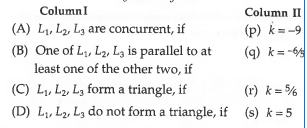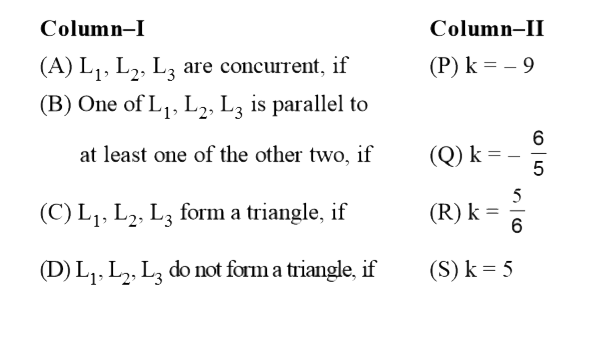Consider the lines given by
L1:x+3y−5=0
L2:3x−ky−1=0
L3:5x+2y−12=0
Match the following lists.

The correct Answer is:a→s; b→p,q; c→r; d→p,q,s
Given lines are
L1:x+3y−5=0
L2:3x−ky−1=0
L3:5x+2y−12=0
L1 and L3 intersect at (2, 1)
∴L1,L2,L3 are concurrent if
6-k-1 = 0 or k=5
For L1,L2 to be parallel
13=3−k⇒k=−9
For L2,L3 to be parallel
35=−k2⇒k=−65
Thus, for k = 5, lines are concurrent and for k=−9,−65, at least two lines are parallelk. So, for these values of k, lines will not form triangle.
Obviously, for k≠5,−9,−65, lines form triangle.
Topper's Solved these Questions
- STRAIGHT LINESBOOK - CENGAGECHAPTER - STRAIGHT LINESEXERCISE - Exercise (Numerical)
13 Videos
- STRAIGHT LINESBOOK - CENGAGECHAPTER - STRAIGHT LINESEXERCISE - JEE Main Previous Year
9 Videos
- STRAIGHT LINESBOOK - CENGAGECHAPTER - STRAIGHT LINESEXERCISE - Exercise (Comprehension)
27 Videos
- STRAIGHT LINEBOOK - CENGAGECHAPTER - STRAIGHT LINEEXERCISE - Multiple Correct Answers Type
8 Videos
- THEORY OF EQUATIONSBOOK - CENGAGECHAPTER - THEORY OF EQUATIONSEXERCISE - JEE Advanced Previous Year
9 Videos
Similar Questions
Consider the lines give by L1:x+3y−5=0,L2:3x−ky−1=0,L3:5x+2y−12=0

View SolutionConsider the lines given by
L1=x+3y–5=0
L2=3x–ky–1=0
L3=5x+2y–12=0
Match the statements/Expression in Column-I with the statements/Expressions in Column-II and indicate your answer by darkening the appropriate bubbles in the 4 × 4 matrix given in OMR.

View Solution
Knowledge Check
The three lines l1=4x−3y+2=0,l2=3x+4y−4=0 and l3=x−7y+6=0
Aform a rt. angled isosceles triangleBform a rt. Angled triangleCare concurrentDNone
Consider the lines given by : L1:x+3y−5=0,L2:3x−ky−1=0,L3:5x+2y−12=0 If a be the value of k for which lines L1,L2,L3 do not form a triangle and c be the value of k for which one of L1,L2,L3 is parallel to at least one of the other lines, then abc=
View SolutionConsider the lines given by : L1:x+3y−5=0,L2:3x−ky−1=0,L3:5x+2y−12=0 If a be the value of k for which lines L1,L2,L3 do not form a triangle and c be the value of k for which one of L1,L2,L3 is parallel to at least one of the other lines, then abc=
View SolutionL1=x+3y−5=0,L2=3x−ky−1=0,L3=5x+2y−12=0 are concurrent if k=
View SolutionConsider the lines given by
L1:x+3y−5=0, L2:3x−ky−1=0 L3:5x+2y−12=0
Column-IColumn-II(A),L1,L2,L3 are concurrent, if(p)k=−9(B) One of L1,L2,L3 is parallel to at least one of the other two, if(q)k=−65(C)L1,L2,L3 from a triangle, if(r)k=56(D)L1,L2,L3 do not from a triangle, if(s)k=5
View SolutionConsider the lines given by L1:x+3y−5=0 L2:3x−ky−1=0 L3:5x+2y−12=0 Column I|Column II L1,L2,L3 are concurrent if|p. k=−9 One of L1,L2,L3 is parallel to at least one of the other two if|q. k=−65 L1,L2,L3 form a triangle if|r. k=56 L1,L2,L3 do not form a triangle if|s. k=5
View SolutionConsider the lines given by
L1=x+3y–5=0
L2=3x–ky–1=0
L3=5x+2y–12=0
Match the statements/Expression in Column-I with the statements/Expressions in Column-II and indicate your answer by darkening the appropriate bubbles in the 4 × 4 matrix given in OMR.

View SolutionConsider the lines: L1:x−21=y−17=z+2−5,L2:x−4=y+3=−z Then which of the following is/are correct ? (A) Point of intersection of L1andL2is(1,−6,3)
View Solution
